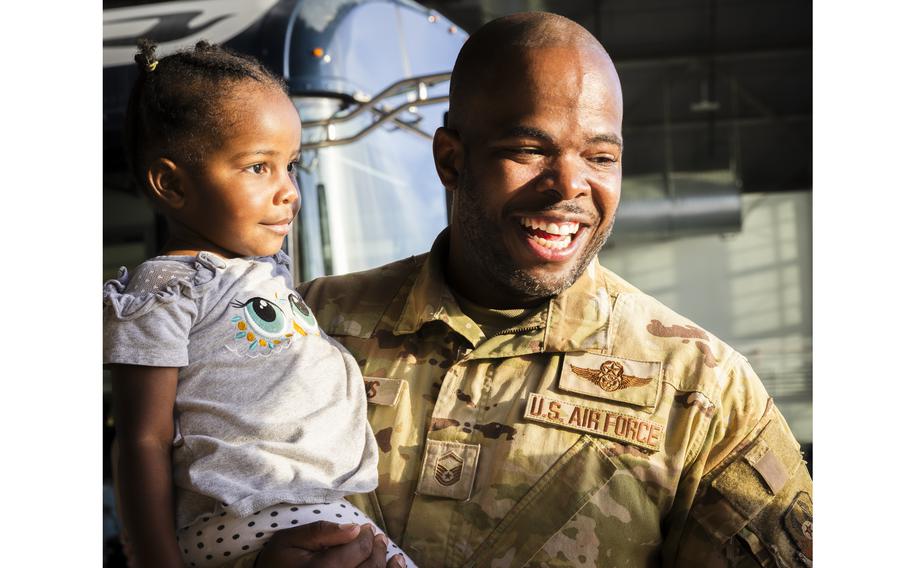
U.S. Air Force Master Sgt. Jonathan Rodgers, a boom operator assigned to the 91st Air Refueling Squadron, is welcomed home by his daughter at MacDill Air Force Base, Florida, Jan. 5, 2025. (U.S. Air Force photo by Staff Sgt. (Lauren Cobin/U.S. Air Force)
I’ve spent decades examining trauma from many angles, and one point that rarely surfaces in mainstream discussions is how today’s environment multiplies stress and anxiety in ways that were not seen decades ago. Service members returning home often enter a society that is already under strain from political polarization, violent events and economic worries. They come back with their own silent weight of combat stress and find it colliding with a culture in which everyone seems pressed to the brink, compounded by the stresses of transitioning back to civilian life.
Another under-recognized issue is how technology, coupled with the 24-hour news cycle, shapes the emotional landscape of those wrestling with post-traumatic stress disorder. I have observed veterans who carry a phone that buzzes with world news of tragedy and conflict. Their distress ramps up when one social media post about global unrest or a fellow veteran’s suicide comes through after midnight. These triggers heighten the endless state of alert that develops as an understandable but punishing coping mechanism so characteristic of PTSD.
We civilians often underestimate how hard it can be for our warriors to ask for help. Their culture emphasizes enduring through pain, prioritizing duty over self. Some veterans don’t recognize how their backfiring coping mechanisms have taken over their lives.
It can become second nature to numb oneself, to stay vigilant and on edge, always ready to respond to danger. Others express their anguish through aggression, isolation, or reckless habits without recognizing these as red flags. A spouse might see the detachment and suspect something is wrong, while the veteran might see that as just another obstacle to handle alone. By the time these individuals finally turn for help, their trauma has solidified into a pattern that can be much harder to reverse.
A significant blind spot is the delayed onset of symptoms. Some veterans leave the service and do well for years. Then a life shift — retirement, family changes, job loss, or current events — brings old war memories flooding back. Many do not realize that PTSD can lie dormant until a new crisis stirs it up.
Beyond the military sphere, the rise in mass violence and communal stress has generated new populations that share parallels with combat veterans. First responders at school shootings, health care workers burned out by pandemic surges, or survivors of large-scale natural disasters — these groups also confront a form of traumatic overload.
There is a growing need to see PTSD as more than just a service-related concern. Our whole society is increasingly shaped by events that push people toward persistent anxiety and trauma. Veterans are often the first to recognize these dynamics, because they faced acute versions of them in combat zones.
None of these observations diminish the immediate crisis highlighted by the tragic death of Army Master Sgt. Matthew Livelsberger or the many others like him. They reveal that our discussions about PTSD must expand. If we keep cycling through the same talking points — awareness, therapy, medication — we will underestimate the underlying shifts in culture, technology and daily pressures that make PTSD harder to heal.
We need broader prevention measures that remain active over a veteran’s entire lifespan, along with mental health approaches that address moral conflict. The uniformed services need to overcome the fear that many service members have that coming forward with their struggles will compromise their careers. We also need a public that is willing to examine how society’s own frantic state contributes to trauma overload for many people.
These thoughts are not meant to dismiss what progress has been made. Therapy is important, the Department of Veterans Affairs has improved access in certain areas, and nonprofits continue to build valuable resources. Yet we have to go beyond simple acknowledgement of PTSD if we hope to reduce tragedies like Master Sgt. Livelsberger’s passing. Veterans deserve care that matches the complexity of their experiences. In a world that feels uncertain for everyone, it is even more important to give them a fighting chance at peace when the uniform comes off.
Robert Cuyler, a psychologist and PTSD and trauma expert, is chief clinical officer of Freespira, an FDA-cleared non-medication treatment that helps people with panic and PTSD manage their symptoms by learning how to regulate their breathing.